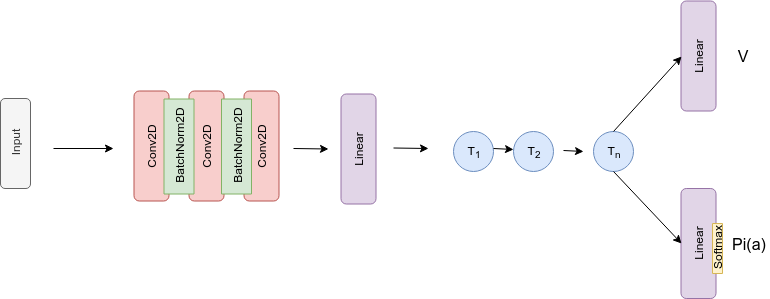Obstacle Tower agent represents a software agent trained with Reinforcement Learning techniques. Main premise is to tackle challenges of Obstacle Tower environment.
Environment is created by Unity team and published as a rich 3D environemnt with navigation and generalization in mind.
This agent is trained with two policy gradient methods, Proximal Policy Optimization and Synchronous Actor Critic. Both methods are combined with ICM module.



Requirements: python 3.5+ and pip.
Dependencies are located in requirements.txt file. Before dependency installation, turning on the GPU is a must, since both PyTorch and Tensorflow requires CUDA and cuDNN installed. Check here for compatibility with your graphic driver and here for installation instructions.
Install dependencies with pip install -r requirements.txt. Note: Having active virtual environemnt is a recommendation.
Obstacle Tower environment can be found here.
Clone environment and install wrapper via pip. Further, download environment itself, unzip it and place it into the root of the project. Detail instructions are at Obstacle Tower Github page.
Running an agent can be achieved with:
python3 -m runner --model_name <model_name>
This will start inference mode with selected model. Pretrained models are placed in models/ directory.
To check all available options run python3 -m runner -h.
Agent runs until in-game time runs up.
Agent training is triggered by running training script: python3 -m agent.learn. This will initialize training with default parameters and it will use A2C as a learning method. Run python3 -m agent.learn -h to check all options and their description.
Training can be visualized with TensorboardX.
After initial collection of observation stops and training starts, run tensorboard --logdir runs/<training_start_timestamp>. This will start server on localhost:6006 by default.
Successful training of a reinforcement learning agent is a difficult job. It requires a lot of knowledge and implementation tricks such as:
- Observation normalization,
- Advantage normalization,
- Scaling rewards by running reward std,
- Custom network initialization etc.
Next few paragraphs will give you some sense of what to expect from environment and what is base agent module and ICM module.
Observation is given as a tuple of one in-game frame, time left and collected keys. Originally frames are given as RGB picture of size 168x168. Frame is downsized to 84x84 which is classical shape in computer vision based Reinforcement Learning, since it lowers graphic memory requirements.
One in-game frame takes a small amount of in-game time and using every frame is unnecessary. For that reason frame-skipping is used. That means that in N consecutive frames we repeat the same action, accumulate rewards and return frame on N-th step.
 converts to
converts to  .
.
Available agent actions are:
Forward/Backward/No-move
Left/Right/No-move
Turn clockwise/Turn counterclockwise
Jump/No-jump
Agent action spaces contains 54 discrete actions if we take all combinations into consideration.
Obstacle Tower is sparse environment which means that agent doesn't receive reward on each action it makes. This makes learning process much slower and harder.
The agent gets reward only for passing through door. Extrinsic (outer) reward is shaped as, passing through door * percentage of remaining time. This enforces agent to go through door as fast as it can.
Also intrinsic reward received from ICM module is added to base reward. This intrinsic reward pushes agent to explore environment.
State (in-game frame) received from environment is input to our base model. It's passed through couple of convolutional blocks and then transformed with linear layer. State, now as a feature vector, is passed through GRU cells. Recurrent block models sequence of events and here is used to replace frame-stacking. Output of RNN is, passed through one fully-connected layer to receive prediction of an value function and passed through another fully-connected layer with softmax activation to create action probability distribution.
ICM module represents a couple of neural network blocks which yield an intrinsic reward. First block is feature extractor, in this case CNN, which receives as an input, current state and a new state. Outcome is feature representation of those states. Next two blocks are, forward model and inverse model. Both models are multi layer perceptrons, where input of the former is action and feature representation of next state and inputs of latter model are feature representations of both current state and next state.
Outcome is predicted feature representation of a next state and predicted action respectively. Intrinsic reward is calculated as mean square error of next state feature representation and predicted feature representation of a next state. This intrinsic reward is added to base reward to increase agent curiosity and improve exploration.

